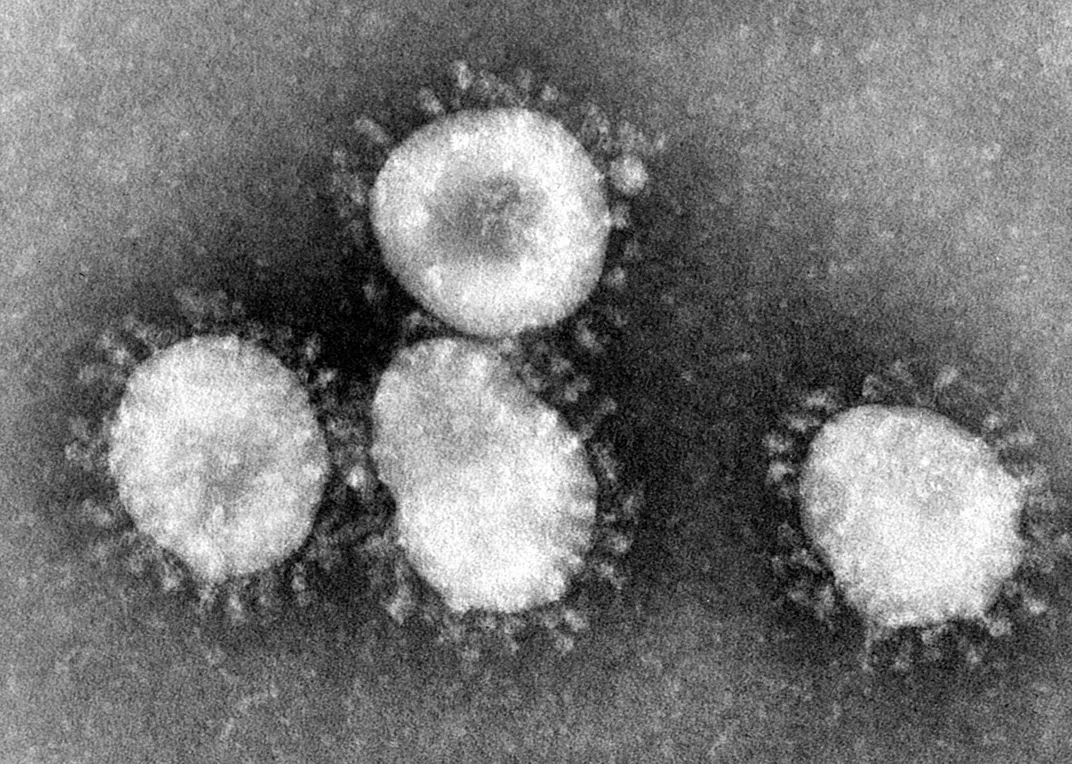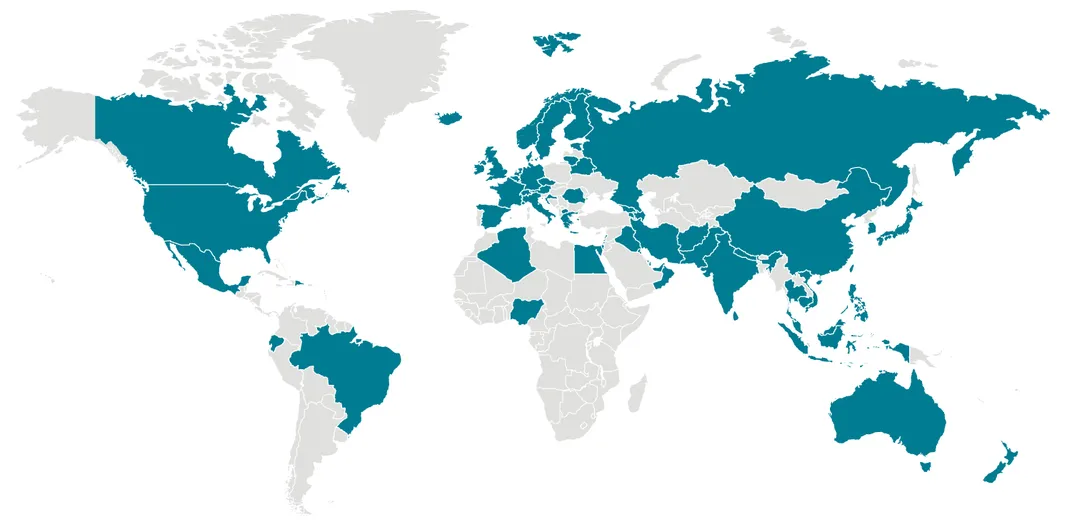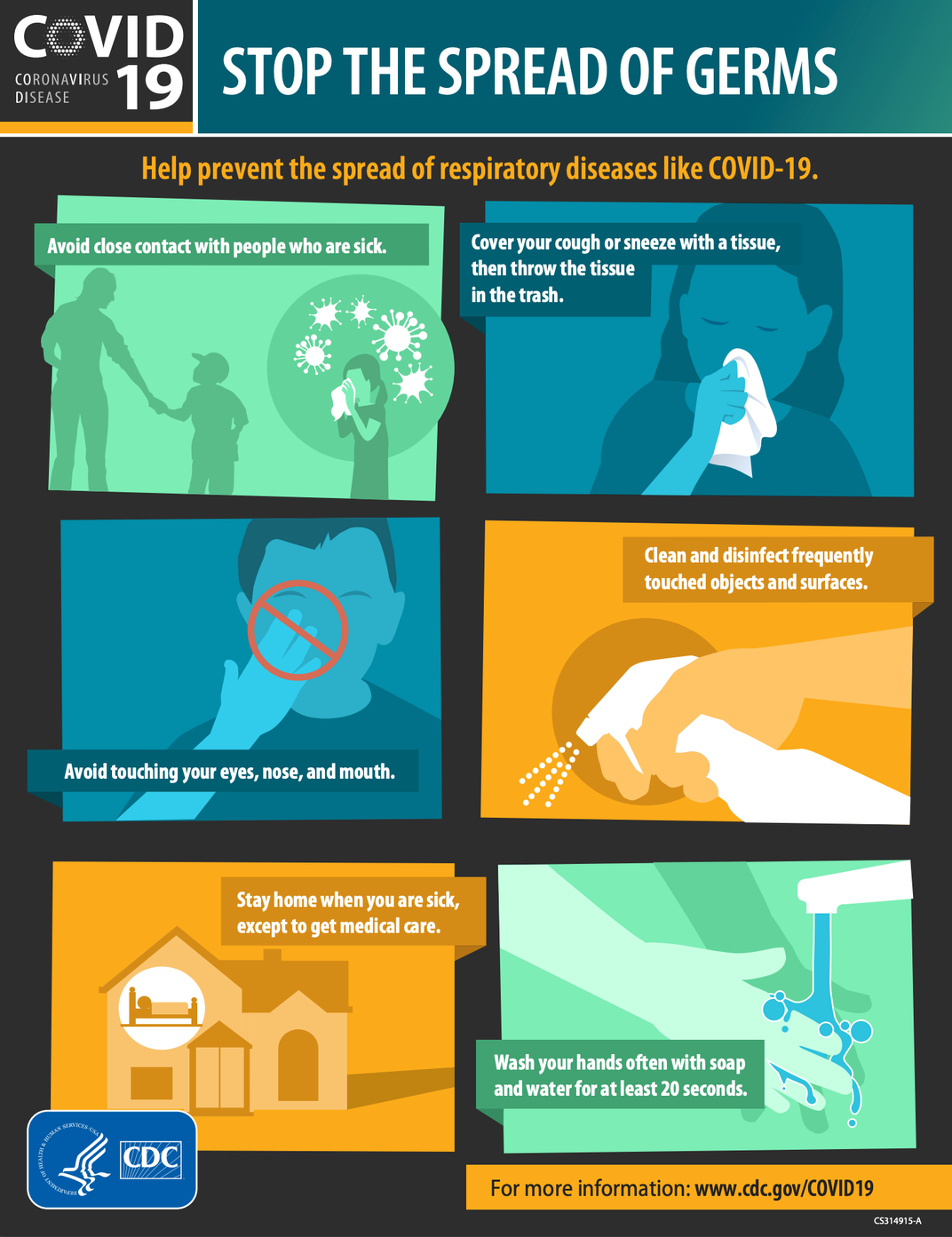A Guide to What to Know About COVID-19
As COVID-19 spreads around the globe, so does misinformation. Here, you can find facts about the virus and infection it causes
/https://tf-cmsv2-smithsonianmag-media.s3.amazonaws.com/filer/79/4a/794a7e74-8c99-4fde-abcd-a303bc302ba1/sars-cov-19.jpg)
Editor's Note, March 6, 2020: This story is developing. For the latest fact and figures, visit the Centers for Disease Control's COVID-19 Situation Summary webpage, updated daily at noon Eastern Time.
More than 101,000 confirmed cases of COVID-19 have been reported worldwide. In the United States, where more than 250 infections have been identified, the disease has spread to at least 20 states, killing 15 people: 14 in Washington state and one in California, as of publication.
Although the Centers for Disease Control and Prevention (CDC) maintain that the immediate health risk posed by COVID-19 remains low for the general American public, Nancy Messonnier, director of the organization’s National Center for Immunization and Respiratory Diseases, has warned that the disease’s spread throughout the country is “not so much a question of if this will happen anymore, but rather more a question of exactly when this will happen.”
As the coronavirus—now officially named SARS-CoV-2—spreads, so too has misinformation, stymieing efforts to educate and protect the global community. Many questions about the virus and the disease remain unanswered. Thanks in part to a solid understanding of other types of coronaviruses that have plagued us in the past, researchers are quickly homing in on COVID-19’s potential impacts and identifying some of the most important preventative measures people can take. Here’s a quick rundown of what we have learned so far.

What exactly is COVID-19?
First, let’s get some terms straight. SARS-CoV-2 is the name of the virus that’s spreading; COVID-19 is the disease it causes. Although most media reports have used the term “coronavirus” to describe SARS-CoV-2, the term is, by itself, not very informative.
Ccoronaviruses comprise an entire branch of the virus family tree that includes the disease-causing pathogens behind SARS, MERS and several variants of the common cold. Using “coronavirus” to refer to a potentially dangerous viral strain is a little bit like saying “mammal” when you mean “lion,” technically accurate, but not specific.
The fact that this new virus belongs to the coronavirus group, however, is telling, as humans have encountered plenty of these pathogens before. Named for the spiky, crown-like fringe that shrouds each viral particle—giving them a “coronated” appearance—coronaviruses tend to target the respiratory systems of bats and other mammals, as well as birds. More often than not, the viruses remain restricted to their wild hosts. But occasionally, they make the hop into humans, as occurred with the 2003 SARS and 2012 MERS outbreaks, both of which likely originated in bats.
The animal source of SARS-CoV-2 has yet to be pinpointed definitively. Given the history, bats remain a probable culprit, with some researchers suspecting the pangolin—an endangered mammal prized on the black market for its scales—as a potential intermediary, reports Joel Achenbach for the Washington Post.
What are the symptoms of COVID-19, and how is it transmitted?
Like other coronaviruses, the COVID-19 virus infiltrates the airways of its hosts. At worst, these pathogens can cause severe forms of viral pneumonia, which in some cases leads to death. Though researchers caution that numbers could shift as the outbreak progresses, the new coronavirus’s fatality rate appears to be around 2 percent. That’s a small fraction of the 10 and 35 percent figures reported for SARS and MERS, respectively.
The vast majority of COVID-19 cases—about 80 percent—appear to be mild, causing a spate of cold-like symptoms like coughing, shortness of breath and fever. Many people are suspected to carry the virus without presenting any symptoms. As physicians continue to identify more of these less-severe cases, which are more difficult to detect, the COVID-19 death rate may drop closer to 1 percent or even below it, reports Denise Grady for the New York Times.
That said, in the few months since it was first reported in China’s Hubei province, COVID-19 has killed about 3,000 people. That’s more than SARS (about 770 deaths) and MERS (about 850 deaths) combined. COVID-19’s death rate suggests the virus is more contagious than these predecessors, as well as most strains of the distantly related influenza virus, according to the Times. (According to the CDC, severe cases of the flu lead to at least 140,000 hospitalizations in the United States each year out of a total of more than 9 million cases of influenza documented annually. With an average of 12,000 deaths each year, influenza’s death rate is about 0.1 percent.)
A reported 2,873 deaths have occurred in Hubei province alone. According to the World Health Organization, COVID-19’s death rate increases with age, with the highest mortality rate of 21.9 percent occurring among people over 80 years of age. Those with underlying medical issues including respiratory and heart conditions, as well as smokers, are among those at highest risk, reports Allison Aubrey at NPR. Despite some reports to the contrary, children can be infected, but appear less vulnerable. Importantly, a multitude of factors—including many that scientists don’t yet understand—can affect how a given person tolerates an infection.
The virus is capable of moving directly from person to person through droplets produced by coughs or sneezes that travel through the air to settle directly on skin or frequently touched surfaces, like doorknobs or cell phones. After a person is exposed, symptoms can take weeks to appear, if they do at all. Those who carry the virus without showing signs of illness can still spread the disease.
How can I protect myself and others?
To avoid infection, the CDC recommends the same preventative actions one should follow during flu season. The top tip? Wash your hands thoroughly for at least 20 seconds, especially before eating, after using the bathroom, and after blowing your nose, coughing or sneezing. Soap can destroy some viruses, but its largest impact comes from dislodging these and other pathogens from skin. If you cannot wash your hands, the CDC notes that alcohol-based sanitizers are a decent second option as long as the sanitizer contains at least 60 percent alcohol. If your hands are visibly dirty, hand sanitizer will not be effective. (Some sanitizers labeled “anti-bacterial” contain only antibiotics, which will not protect against viruses.)
Based on preliminary estimates of contagiousness, those infected with SARS-CoV-2 are expected to infect two or three more people on average, according to WHO. If someone is already sick, wearing a face mask can reduce the spread of disease. However, most face masks, including loose-fitting surgical masks, are not effective at protecting individuals from respiratory diseases. Even medical-grade N95 masks, named for their ability to filter 95 percent of airborne particles, are difficult to use without training and won’t be airtight unless they are professionally fit-tested, says Timothy Brewer, an epidemiologist at UCLA, to Washington Post. Ultimately, N95 masks should be reserved for health workers and those who suspect they may have fallen ill.
Above all, don’t panic, Brewer tells Washington Post. While many media outlets have framed the current situation as one that does not “yet” warrant panic, at no point will excessive anxiety or rash behavior help contain the pathogen’s spread. Infection is by no means a death sentence, and should not be treated as one. “Don’t let fear and emotion drive the response to this virus,” Brewer says.
What about antiviral treatments or a vaccine?
Vaccines to combat SARS-CoV-2 are being developed, but requisite safety testing is likely to keep any new formulation off the market for months or possibly years. Vaccines also tend to be less effective in older individuals with weaker immune systems—the very people that the virus most strongly affects.
However, a drug to treat patients may be available sooner, reports Matthew Herper and Damien Garde for STAT News. It is important to remember that thousands—approximately 45,000 people in total, according to Johns Hopkins University—around the world have already recovered from the disease—many never knowing they had it in the first place.
What has been the economic and cultural impact of the outbreak?
As of Monday, March 2, SARS-CoV-2 had reached at least 60 countries. But nearly all nations have been affected by the disease’s cultural aftershocks as the global community struggles to contain its spread.
As businesses and cultural institutions continue to close, economists warn of severe stagnation in the global economy. Here in the United States, the government has issued travel alerts for China, South Korea, Italy, Iran and Japan—the five countries with the most cases to date—stressing that all non-essential trips should be canceled or postponed. The American stock market just suffered through its worst week since the 2008 Great Recession.
In Japan, lawmakers have shocked parents and guardians by suspending classes nationwide. China, which celebrated Lunar New Year at the end of January, has struggled to get back on its feet as workers remain homebound, leaving factories empty and international orders for products unmet. In France, where at least two people have died from the disease, indoor gatherings of 5,000 people or more are now prohibited, and the Louvre museum has closed its doors.
Following close on the virus’ heels has also been a wave of prejudice against people of Asian ancestry. Reports of people avoiding Chinese restaurants and shirking packages shipped from China have peppered the news cycle. (To be clear, Chinese food is no riskier than any other cuisine. Receiving packages from China also remains completely safe, according to the World Health Organization. Viruses, which need to enter living cells to replicate and propagate, don’t last long on objects exposed to the elements, especially when they’re being shipped overseas at room temperature.)
A similar display of discrimination followed the spread of SARS in 2003, when media reports began to ubiquitously lead their coverage with images of people of Asian descent wearing face masks. As medical anthropologist Laura Eichelberger told Undark magazine last month, these “innumerable pictures … racialized the epidemic by identifying Asian bodies as the source of contagion, contributing to their stigmatization.”

What’s next?
In anticipation of COVID-19’s continued spread, the United States has ramped up its diagnostic efforts, which will undoubtedly reveal more cases, reports Nell Greenfieldboyce for NPR. These reports aren’t necessarily an indication that the virus is spreading faster, only that health officials are becoming more aware of its movements within American borders.
Like other coronaviruses as well as the flu, SARS-CoV-2 might follow a seasonal pattern, waning as the weather warms before rising to a second peak in the fall. But this ebb and flow is not guaranteed, and most experts hesitate to forecast when the outbreak will come to a close. Before then, thousands more will certainly be sickened, likely reaching the point where COVID-19 becomes a pandemic, or a disease that’s rapidly spread worldwide, according to the WHO. So far, both the CDC and WHO have been hesitant to give this formal designation, hoping to avoid triggering a panic.
Still, semantics don’t change reality. Officials worldwide have stressed the importance of practicality and preparedness for institutions and individuals. As hospitals revamp their protocols to ready themselves for an influx of patients, governments must weather what might be a prolonged period of suspended travel and trade.
Speaking with NPR, the Center for Global Health Science and Security’s Rebecca Katz recommends stocking up on essentials like medications and non-perishable pantry items, in case a local outbreak makes frequent trips to the store imprudent.
Above all, information and transparency remain humankind’s greatest weapons against disease—especially as the epidemic and its repercussions continue to evolve. The virus is unlikely to disappear anytime soon, and the best we can do is take its presence in stride and try to learn from past mistakes.
Editor’s Note, March 6, 2020: This story was updated to reflect current data from the Centers for Disease Control regarding the outbreak in the United States.

Glossary of COVID-19 terms
Antiviral
-
A medicine that specifically targets and inactivates viruses. Distinct from an antibiotic, which targets bacteria.
Comorbid
-
The simultaneous presence of two or more diseases in a patient. Patients with pre-existing respiratory illnesses, for example, face a higher mortality rate when infected with COVID-19.
Coronavirus
-
The name given to the members of a large group of viruses that includes the disease-causing pathogens of COVID-19, SARS, MERS and several variants of the common cold.
COVID-19
-
The disease caused by SARS-CoV-2, first detected in China’s Hubei province in 2019. COVID-19 stands for “coronavirus disease 2019.”
Disease transmission
-
How a disease is transferred from person to person. COVID-19 is transmitted by droplets from the airways—the wet flecks produced by sneezing, coughing or sometimes even talking. If these droplets land on another person’s mouth, nose or eyes (or a hand that touches those parts), it can result in infection.
Droplet
-
The spray produced by sneezing, coughing or sometimes even talking. When produced by a person infected by a pathogen, droplets can spread disease.
Epidemic
-
A large outbreak that spreads quickly or unexpectedly within a population or restricted geographic region.
Fatality or mortality rate; also called case fatality rate or crude fatality ratio (CFR)
-
In a group of people with a given disease, the proportion who die of the disease.
Outbreak
-
A sudden increase in the number of cases of a disease, above what is expected for a specific place or time.
Pandemic
-
An epidemic that has spread over several countries or continents at a rapid pace, usually affecting a large number of people.
Pathogen
-
Bacteria, viruses or other microorganisms that cause disease
SARS-CoV-2
-
The official name of the virus behind COVID-19, named for its genetic similarity to SARS-CoV, which caused an outbreak of SARS in 2003. Often referred to as the “novel” or “new” coronavirus, or simply “coronavirus.”
Stigmatization
-
A set of negative and unfair beliefs associated with a specific group of people. The COVID-19 outbreak has triggered extreme stigmatization of people with cold-like symptoms, especially those of Asian descent.
Vaccine
-
A medical formulation that teaches the immune system to recognize and destroy a pathogen without causing disease. This is usually accomplished by introducing the body to a weakened or partial form of the pathogen in question. No vaccine yet exists for SARS-CoV-2.
Zoonotic
-
A term used to describe a disease that passes from animals to people. Many coronaviruses, including SARS, MERS, and SARS-CoV-2, are zoonotic in nature.
/https://tf-cmsv2-smithsonianmag-media.s3.amazonaws.com/accounts/headshot/10172852_10152012979290896_320129237_n.jpg)



/https://tf-cmsv2-smithsonianmag-media.s3.amazonaws.com/accounts/headshot/10172852_10152012979290896_320129237_n.jpg)